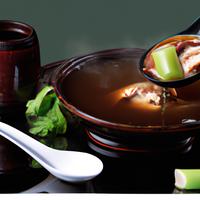
1 serving (240 grams) contains 40 calories, 6.0 grams of protein, 1.0 grams of fat, and 2.0 grams of carbohydrates.

Log this food in SnapCalorie

Nutrition Information
Calories |
40.0 | ||
|---|---|---|---|
% Daily Value* |
|||
| Total Fat | 1.0 g | 1% | |
| Saturated Fat | 0.3 g | 1% | |
| Polyunsaturated Fat | 0 g | ||
| Cholesterol | 10.0 mg | 3% | |
| Sodium | 800.0 mg | 34% | |
| Total Carbohydrates | 2.0 g | 0% | |
| Dietary Fiber | 0 g | 0% | |
| Sugars | 1.0 g | ||
| protein | 6 g | 12% | |
| Vitamin D | 0 mcg | 0% | |
| Calcium | 10.0 mg | 0% | |
| Iron | 0.5 mg | 2% | |
| Potassium | 50.0 mg | 1% | |
* Percent Daily Values are based on a 2,000 calorie diet. Your daily values may be higher or lower depending on your calorie needs.
Food Attributes
Source of Calories
About Chinese broth
Chinese broth is a flavorful, aromatic base commonly used in traditional Chinese cuisine. Typically made by simmering ingredients like meats (such as chicken, pork, or beef), bones, and a variety of herbs and vegetables—ginger, garlic, scallions, and sometimes dried mushrooms—it achieves a deep, umami-rich taste. Often light and clear, Chinese broth serves as the foundation for soups, stews, or noodle dishes, balancing flavors and showcasing natural ingredients. Its nutritional profile depends on the preparation method. Homemade versions are generally healthy, offering vitamins, minerals, and collagen from slow-cooked bones, alongside antioxidants from garlic and ginger. However, some recipes may have high sodium due to added soy sauce or store-bought options. Low-fat and nutrient-dense, it’s a versatile dish for anyone seeking a comforting and wholesome addition to their diet.



